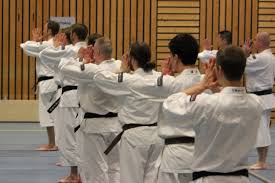Bowing, rei is a very important ritual and etiquette in a martial art dojo. The literal meaning of the word "rei" is “thanks” or “gratitude.”One can understand, how much importance one should give by this following quote of Sensei Gichin Funakoshi.
"Karate-do begins and ends with bowing".空手道は礼に始まり礼に終る事を忘るな karate-do wa rei ni hajimari rei ni owaru koto o wasuruna.
Importance of the spirit of respect is expressed in the dojo bows which are always performed before and after a practice session or a contest. I describe here the common etiquette followed in the standard Wado dojos all over the world.
1.Ritsurei 立礼
Ritsurei 立礼 also known as "Tachi rei" 立ち礼 means Standing bow.Bows are distinguished by their depth, deeper bow distinguish more respect than the formal bow. And it's for more difference in rank.
Let's see the types





Peace and harmony,
Sensei M.Maharaj
"Karate-do begins and ends with bowing".空手道は礼に始まり礼に終る事を忘るな karate-do wa rei ni hajimari rei ni owaru koto o wasuruna.
Importance of the spirit of respect is expressed in the dojo bows which are always performed before and after a practice session or a contest. I describe here the common etiquette followed in the standard Wado dojos all over the world.
1.Ritsurei 立礼
Ritsurei 立礼 also known as "Tachi rei" 立ち礼 means Standing bow.Bows are distinguished by their depth, deeper bow distinguish more respect than the formal bow. And it's for more difference in rank.
Let's see the types
- Eshaku 会釈 or mokurei 目礼 (silent bow) is the informal 15° bow. It means 会釈 "Nod". This letter 会 "Kai" it means "Meeting";"Association". When one bows this way in the dojo, should maintain eye contact, used when facing an opponent or training partner. And it should be hold for a second at the bottom.The purpose is to be alert always before,during and also even after combat.
- Keirei 敬礼 is a more formal 30° bow. This first kanji 敬 "Kei" letter refers to "reverence;respect".And this is 礼 "Rei" means bow. On mundane things, it is used to do in meetings, or to bow to one's seniors, superiors, customers, clients. In wado dōjō, this is the standard bow when one is not facing an opponent or practice partner.This is the most common one. It indicates appreciation and more respect. Keirei as the first move in kata; the eyes look down at an angle
- Saikeirei 最敬礼 is the very formal 45°- 90° standing bow, used on ceremonial occasions like funerals or bowing to the Emperor. First letter Kanji "Sai" 最 refers to "The Top; the most; the extreme". This second kanji 敬 "Kei" letter refers to "reverence;respect". And this is 礼 "Rei" means bow.
- Tagai ni rei 互いに礼 also known as sōgo no rei 相互の礼- Bow to each other. The first two letters 互い "Tagai" refers to "Each other" "Mutual". Third letter に is a numeric "Two". And this is 礼 "Rei" means bow. It should be done in the way of Eshaku 会釈 or mokurei 目礼 (silent bow) the informal 15° bow before and after combat.
- Gasshō rei 合掌礼, an another type of ritsurei with a prayer hand position. The way we do in "India". The first kanji of gasshō 合掌 is 合 (unite;fit;join) and has the alternative pronunciation of ai. The second kanji is shō 掌 palm (of one's hand). Gasshō rei means pressing one’s hands together in a way of Indian prayer gesture and then bowing. Shōrinji Kempō practitioners use this version of bow. In Japan, it is one of the way to express "Apology".
I will write about Zarei, seiza bowing in our next post, which will be out in a day or two.
Peace and harmony,
Sensei M.Maharaj
No comments:
Post a Comment
Thanks a lot for your support and response!
Peace and harmony,
Sensei M.Maharaj